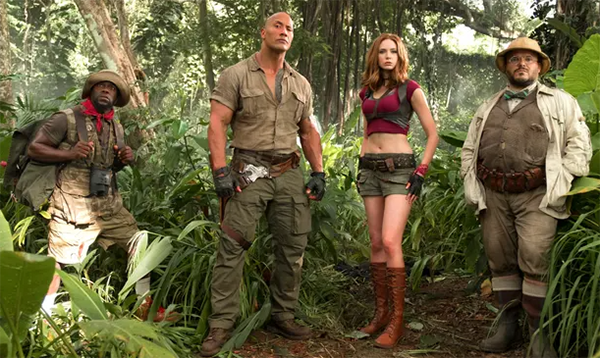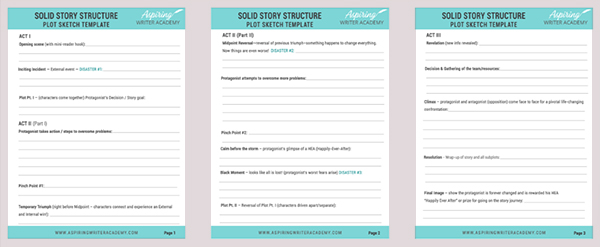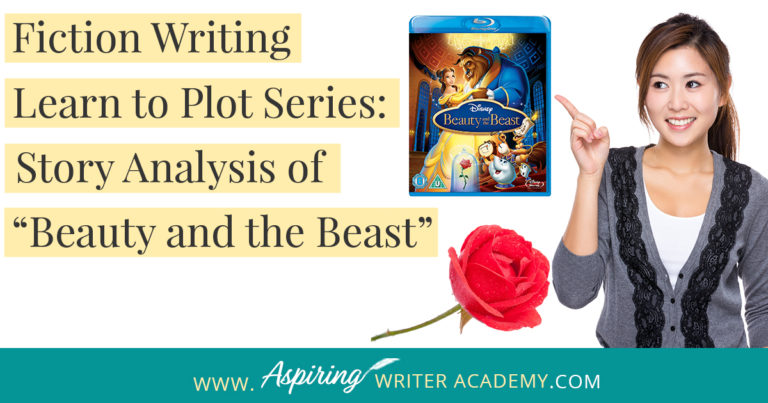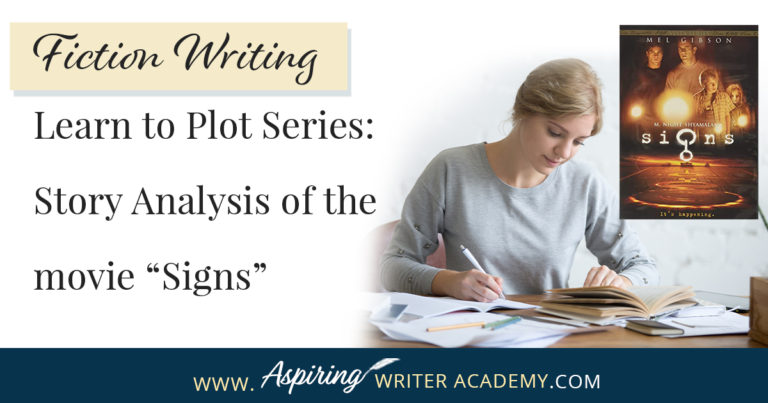Learn to Plot Fiction Writing Series: Story Analysis of the movie “Jumanji: Welcome to the Jungle”

The best way to learn story structure is to analyze good stories. Can you readily identify each plot point in every movie you see or book you read? Or do terms like ‘inciting incident,’ ‘midpoint reversal,’ and ‘black moment’ leave you confused?
In our Learn to Plot Fiction Writing Series: Story Analysis of the movie “Jumanji: Welcome to the Jungle” we show you how to recognize each element and provide a Free Plot Template so you can draft satisfying, high-quality stories of your own.

Sony Pictures Entertainment Movie Blurb:
Four teenagers in detention discover an old video game console with a game they’ve never heard of. When they decide to play, they are immediately sucked into the jungle world of Jumanji in the bodies of their avatars (Dwayne Johnson, Jack Black, Kevin Hart, and Karen Gillan). They’ll have to complete the adventure of their lives filled with fun, thrills and danger or be stuck in the game forever!
This movie was released in September 2018, and is a sequel to the 1995 movie, “Jumanji” starring Robin Williams.
Watch on Amazon: Click Here
One of the best ways to learn story structure is to analyze as many movies and books as you can. We suggest you watch movies because you can see the whole story played out before you visually in approximately two hours, which may be quicker than reading an entire book.
We also suggest that you watch the movie with our Free Downloadable Solid Story Structure Plot Template beside you so that you can write down each plot point as soon as you see it appear on the screen. Do this twenty or so more times and you will soon be on your way to becoming a story structure expert!
Click to download our free Solid Story Structure Plot Sketch Template to help you analyze books or movies, and plot stories of your very own.
Warning! This post contains story spoilers. If you have not already seen the movie and do not want any story spoilers the first time around, you might want to watch the movie for enjoyment then watch it a second time using this post to help you identify each story element.
ACT I
Opening Scenes:
What do the opening scenes of “Jumanji: Welcome to the Jungle” accomplish? How do they serve to set up the story?
- Setting.
First, you need to establish the ‘ordinary world.’ The location and discovery of the game “Jumanji” is established along with the fact that the game seems to have consciousness and ominous special powers.
When the movie opens, the year is 1996 in Brantford, New Hampshire and we see teenagers find the board game “Jumanji” in the sand. The game had been buried there at the end of the original story set in 1969. (This connects Jumanji: Welcome to the Jungle with the original Jumanji movie (released 1995) which starred Robin Williams as “Alan Parrish.”
- The first scene opens with an interesting situation (initial problem).
The story opens with the characters facing an initial problem, which acts as a hook to grab the reader’s attention. This isn’t the main problem yet, but a situation or event to get the story rolling. It is a scene that will tie into the major problem later.
One boy, Alex, takes the game home, and when he opens the lid and realizes it is a board game, he says it is boring and sets it aside. Times have changed and the game senses it needs to change too and transforms into a video game cartridge. Later that night, the teen hears Jumanji’s “drums” and after he starts to play the new video game, we see a glimpse of his house with bright flashing lights exploding from within. This tells us something peculiar and special is happening, piquing our interest.
- Introduction of the main characters, their personalities, and the character’s relationships with one another. Also hint at the internal (relationship) conflict and escalating external conflict.
The next segment of scenes jumps forward twenty years to 2016 and introduces four more teenagers (the main characters of this story.)
- Spencer is a smart, skinny, high school nerd who likes video games. He does homework for a popular football jock nicknamed “Fridge” hoping they might become friends again, like when they were younger.
- Fridge is a tall athlete with a large build, known for his strength and speed. He is used to being popular, one who gets his way. It is obvious he is just using Spencer to complete his school assignments so that he can get good grades and remain on the football team. However, when they get caught, Spencer and Fridge both end up in detention.
- Bethany is also popular, into flirting and fashion and talking on her cell phone. She is obsessed with her self-image and takes selfies of herself and posts on social media. She is also shown as self-centered and inconsiderate to everyone else in the classroom, which lands her in after-school detention.
- Martha is a shy, conservatively dressed bookworm who would never likely be friends with someone like Bethany. However, she too gets detention when she stands up to a teacher and refuses to participate in gym class. Unbeknownst to her, this also earns her respect from Spencer who admires her from afar.
None of these four characters would naturally be friends. It will be the story that pushes them together and helps them to change and grow. Hints of their strengths and weaknesses (their personality flaws) and the relationship conflicts they will need to overcome are already set in place.
Note: All of these ‘details’ are set up pieces that will show up again later and impact the story. Everything your character needs at the end should be set up in the beginning, so it is believable for the reader/viewer.
Ask—who are these characters and what will they need?
Inciting Incident:
After the opening scenes have introduced the characters and set up the genre, time period, location, hinted theme, and general pacing of the story, the protagonist is hit with the inciting incident, which rocks his (or her) ‘ordinary world’ and turns his life upside down. This serious problem cannot be ignored.
The protagonist must now decide how to deal with this serious problem, which becomes his new focus for the remainder of the story. The action plan to overcome this serious problem becomes the protagonist’s story-worthy goal.
In the movie, Jumanji: Welcome to the Jungle, the Inciting Incident occurs when the four teens (Spencer, Fridge, Bethany, and Martha) go to detention. The theme is introduced here when the principle says he wants them to reflect and ask themselves: “Who are you?”
Although you might say all of the above characters are the protagonists of the story, only one is usually the true protagonist, the one the story gives the most focus. In this story, the true protagonist is Spencer. The current story opens and finishes with him, and it is he who is the one who accomplishes the tasks needed at the turning points of the story (with the others’ help.)
Their task is to remove staples from magazines for recycling in the school’s basement. But when they find an old video game console and play “Jumanji” the game starts showering them with sparks and they disappear as they get sucked into the virtual world of the game.
The Inciting Incident or decision to go on the story journey often sends the characters through a doorway, or to a new location via a method of travel. The start of the new adventure separates Act I and Act II.
To the teenagers’ surprise, they soon realize that they are in the jungle living in the avatar bodies of the game pieces they had each chosen. (And each of their bodies is far different than the one they left behind.)
Spencer is Dr. Smolder Bravestone, and is now big, muscular, strong, and bald!
Fridge is Franklin Finbar, a small, short little zoologist who can no longer push others around!
Bethany is Professor Shelly Oberon, who is not only older and fat, but a man!
Martha is Ruby Roundhouse who finds herself dressed in sexy shorts and a leather halter top!
They realize that they must be in the game when a hippo eats Bethany and she comes back by falling from the sky with a definitive ‘ding.’ One of the three tattoos she had on her arm is gone and they realize the tattoos indicate their ‘lifeforce’ and how many ‘lives’ in the game they each have left. This also starts a ticking clock or countdown for the reader which adds tension.
Note: The inciting incident is also referred to as the first major turning point to turn the story in a different direction or Disaster #1. What happens at the inciting incident is a game-changer.
If you are not familiar with the elements of solid story structure for popular fiction, you may want to see our post, How to Plot Your Fictional Novel, to help you further understand the specifics of what should be included in each section.
Plot Point I:
Plot Point I is the agreement between characters or decision the main character makes to accomplish a new story-worthy goal triggered by or in response to the inciting incident. This decision ends Act I. The main characters will unite to overcome the Inciting Incident problem.
In Jumanji: Welcome to the Jungle, a guide named Nigel drives up in a jeep and explains the rules of the game. They need to take the green jewel he gives them and return it to its rightful place high up on a mountaintop jaguar statue or they will be stuck in the game forever!
“Return the jewel and lift the curse.”
The stakes are set. They cannot ignore this problem, presented by the antagonist (the game). The goal will not be easy and there are dire consequences if they fail to achieve this goal. They will have to follow a map and piece together clues to find the statue. The goal is dangerous. They also need to keep the jewel away from a formidable villain and his motorcycle riding minions.
Left with no choice, the four teenagers must accept the mission and win the game, or they will never be the same again.
This is the teenagers’ new story-worthy goal, which also sets up the story question: Will these four teenagers find a way to return the jewel to the jaguar statue and win the game so they can return to their rightful bodies?
The audience is hooked and will continue watching/reading until the end of the story when this question is answered.
ACT II (Part I)
Now we journey into the main body of the story where the characters are learning to navigate their new ‘world/situation.’ The characters are learning, growing, being tested in their skills and in their relationships with one another. They are acquiring the know-how to face and deal with what is to come during the later segments of the story.
If the characters did not already transport to another location at the Inciting Incident, they may do so after the Plot Pt. I decision to go on the story journey. If the character does not actually travel, he may start a new job, or join a new group, or start to do something new, something that takes the character out of their comfort zone.
In Jumanji: Welcome to the Jungle, each character in is reaction mode during the first half of Act II as they learn to navigate their new circumstances.
Spencer accidentally presses a hand to his chest and a virtual screen pops up in the air displaying his game piece character stats. As the others do the same, they learn that they each have special strengths and weaknesses. They are learning who their ‘character’s’ are.
Fridge is not used to being Spencer’s sidekick because it is usually the other way around and he has a problem with that. The two are seen fighting and squabbling several times.
The group must follow the map and go to the bazaar and find the ‘missing piece’ but they do not know what that means.
Escalating events:
The villain’s motorcycle-riding minions chase them and try to shoot them with rocket launchers. The teenage group runs, dodging the explosions. Using some of the new strengths of her character, Martha (Ruby Roundhouse) finds that she can powerfully kick and defeat some of them. And when the group comes to the edge of a huge waterfall they all have to jump in order to escape. These are actions the teenagers never would have done back home.
Martha discovers she got hit by the villains and disappears, then falls from the sky back into the game with one of her lifeforce tattoos missing. She only has two left.
Pinch Point #1:
This emotional moment usually occurs about midway through the first half of Act II.
- The teenagers challenge each other over personal differences and we see why they aren’t all friends. Martha and Bethany squabble, and then Spencer and Fridge fight and when Spencer falls over a cliff and reappears falling from the sky with one less life bar, they realize they must all work together or they might all die in the game and never get home.
- The first pinch point serves to remind the main protagonist all he could lose if he doesn’t attain his goal (of winning the game before their life forces run out.) Pinch Point #1 also motivates him to continue forward with renewed resolve. He will not give up!
More escalating events:
- The group goes to the market and Fridge eats what he thinks is bread, but it is cake (one of his character’s weaknesses) and he explodes. He also returns with one life force down. Now they each only have two life force bars left.
- A child leads them to a room with a basket to find the ‘missing piece.’ A giant poisonous snake is in the basket and they quickly close the lid. They are told to ‘trust one another and never blink.’ This is the first time they all work together to accomplish a task. Spencer lifts the lid, and Bethany tries a stare-down contest with the snake, while Fridge, a zoologist grabs the snake by the neck and snips its fangs. Martha grabs the package at the bottom of the basket with an elephant statue inside. There is also a note: ‘when you see me begin the climb.’ Another clue.
Temporary Triumph:
In most stories the characters experience an unexpected win in the external plot thread that triggers a celebratory win or triumph between the characters in the internal plot thread. In a romance, this is where the characters may share some backstory and kiss. It looks like the characters may be able to achieve their goal and will get their happily-ever-after. This is a moment of hope, that yes, the character can win.
- Encouraged by their win defeating the snake and finding the next clue, Spencer feels empowered and when the motorcycle villains return to chase them once again, Spencer uses his character’s strength to fight and defeat the bag guys. He is starting to believe in himself and his abilities. The others watch him in disbelief and are in awe of him. They all begin to believe they can win!
ACT II (Part 2)
Midpoint Reversal
Bam! Just when everything seems fine and the goal within reach, an event happens at Midpoint, the second major plot point, to turn the story (and all the plot threads) in a different direction again. Disaster #2 changes everything and reverses the short-lived temporary triumph. In a relationship story, it changes the relationship.
- The head villain meets them face-to-face and demands they give him the jewel. It seems the group is trapped with no way out.
- However, the teenagers escape when another teenage boy causes a disturbance and helps them get away. The new teen hides them in the tunnels, and they follow him back out to the jungle. He takes them to a treehouse where he has been living, a place built by Alan Parish (from the original movie when he was pulled into the game.) Humor is added when we see that Bethany is attracted to this new boy and thinks he’s cute, except she is in her avatar male body, which her romantic interest is not attracted to.
- This new teen is Alex (remember the teen who found the game and disappeared in the very first scene?) He too was sucked into the game and has not been able to make it out without the other players. He is very happy to see them for now he thinks they have a chance to win the game. His character is Jefferson “Seaplane” McDonough, a pilot. The other teens remember that when they started playing the game, that game piece character had already been taken. They realize that Alex must be ‘the missing piece,’ the one they needed to find! This changes everything!
- They now know that they need to fly across a deep ravine to return the jewel to the jaguar statue. Alex only has one life force bar tattooed to his arm and he is afraid he might die. He has never managed to cross the ravine on his own. However, the group agrees to work together to win the game and they come up with a proactive plan.
While many of the lessons learned in the first half of Act I may have been more exploratory or reactive, the second half is stepping out to use and test those lessons proactively. The characters have now been enlightened as to what is really going on and they are going after what they want!
- Escalating events:
The group needs to distract two guards standing outside a large hangar so they can get to a plane. The only one who can do this is Martha (Ruby Roundhouse), the only one who looks female, except she doesn’t know how to flirt, and Bethany must teach her how (which adds humor).
Fridge tells Spencer that Martha likes him, and he is filled with anxiety, because he likes her too and doesn’t know what to do about it. And when Alex mentions he thinks Cindy Crawford (now almost 50 years old) is ‘fly’ and uses outdated slang, the others ask him what year he thinks it is. Alex thinks it is still 1996. When he finds out he’s been in the game twenty years, he is sad. The group realizes he is the boy who lives in the freak house who disappeared a long time ago.
While Martha doesn’t think she can distract the guards, Spencer encourages her. It starts off horribly wrong as Martha fails in her flirting endeavors, but then she sees a radio and starts dance-fighting along with the music (her character’s strength.) She succeeds in distracting the guards and gains the admiration of the rest of the group.
Alex has never been past this point in the game before and is afraid to fly—he always crashes. Instead of a seaplane, they take a helicopter just as the villain’s motorcycle minions come to give chase.
To the teenage group’s dismay, the helicopter is broken and can’t fly very high and a herd of rhinos are charging toward them. Spencer goes out on top of the helicopter to fix the broken lever and it works, they can fly higher to escape the rhinos!
But Fridge has to tell them he accidentally dropped the jewel when the helicopter tilted sideways. Now they have to go back. Spencer throws Fridge out of the helicopter and the rhinos chase him. Meanwhile, Alex lowers the helicopter and Spencer jumps down and grabs the jewel. Once back in the helicopter, they fly low over the herd and Spencer takes his arm and grabs Fridge and hauls him back into the helicopter to safety.
Pinch Point #2:
About halfway through the second half of Act II, we have Pinch Point #2. Another moment to pull on the heartstrings. While Pinch Point #1 may have led the main character to see all they had to lose if they did not press forward with their goal, Pinch Point #2 leads them to see all they might gain.
- Because of the enormous win the group just had, they celebrate their victory. They are working together, actively using their avatar character strengths, and experiencing success!
- Then when they land, Alex suddenly gets bit by a mosquito and mosquito bites are his avatar character’s weakness! His last life-force tattoo bar starts to disappear, and the group realizes Alex will die! But Bethany sacrifices one of her last two bars to save Alex’s life when she gives him CPR. Alex thanks Bethany for saving his life and they all realize once again that they have to beat Jumunji and win this game so they all have a chance to live.
While Pinch Pt. #1 gave them a glimpse of what they could lose, Pinch Pt. #2 gives them a glimpse of what they could win. They are looking to the future and what they have to gain. This reinforces their motivation once again to achieve their goal.
The Calm Before the Storm:
This is a moment when the story takes a slight pause so the audience can catch their breath. This can be another moment of hope that all will be well, similar to the temporary triumph. The character may see or experience something to give them hope for the future or a reason to press on.
- Alex is thinking about his past and talking with Bethany, who he is getting to know better.
- Spencer tells Martha he likes her while he is still brave like “Dr. Bravestone.” He admits that he has liked her since the 7th grade. Martha reveals she likes him too and she never admits her feelings. While brave, they try to kiss but humorously fail. It looks like they might have another real kiss, but Fridge interrupts.
The Black Moment:
The black moment is the dark night of the soul, the bleakest moment, which is also the third major turning point, Game Changer, or Disaster #3. It appears that all hope is lost.
- The group sees the jaguar statue on the mountain top and find the elephant and remember the clue ‘when you see the elephant, start the climb.’ Spencer says he will climb through the trees to get to the statue. But when he is attacked by a large jaguar cat, he dies, and loses a life-force bar. He only has one left and he panics, fearing he can’t do this. He failed.
Plot Point II:
Plot Point II follows quickly on the heels of the Black Moment. This is when the characters separate or are driven apart due to the events of the Black Moment. The protagonist finds himself alone, struggling with what to do next.
At Plot Pt. II the characters are driven apart. (This is a reversal of Plot Pt. I where the characters all came together.)
- Spencer tried to accomplish the task of returning the jewel to the jaguar statue on his own, which separated him from the other characters. While experiencing his initial feelings of failure, he was alone. This was a very low moment for him indeed.
ACT III
Revelation:
Then, suddenly the protagonist gets a new piece of information that changes the situation, and the characters can see how they might succeed in their battle against the external antagonist which they must face.
- The story’s theme is presented here as Fridge consoles Spencer after his failure and gives him special insight. When Spencer forlornly tells Fridge that he can’t do it, and shows him his tattoo, and says, “I only have one life,” it is clear he is afraid to die. To which Fridge responds, “We all only have one life. It’s how we are going to live it that matters.” (Not only is this true for their avatar characters but also hits the heart that this is also true for their real lives. It is also true for the viewer/reader as they apply that insight to their own lives.
- This inspires Spencer and gives him hope.
Decision:
The revelation (new information revealed) helps the protagonist to make a decision.
- Despite only having one life-force bar left, Spencer decides to give it his all and try to defeat this Jumanji game once and for all.
Re-gathering of the Team or Resources:
Whatever people, tools, items are going to be needed for the climax are gathered together. If the protagonist’s team was separated at Plot Pt. II, this is when they come back together, realizing they need one another.
- Spencer and Fridge unite with the rest of the group and Fridge assigns roles and lays out a gameplan to get the jewel back to the jaguar statue much like he would for a game-winning football play.
Climax:
This is the most exciting scene sequence in the entire book or movie. This is a face-to-face confrontation between the protagonist (and his team) and the opposition. Either the protagonist succeeds once and for all or he fails. Everything is put on the line. It will not be easy.
- Martha uses her avatar’s strength and dance-fights to take out members of the villain’s motorcycle minions.
- Spencer takes one of the motorcycles, while Bethany fights off a large jaguar cat. Spencer uses a flame torch to circle several jaguars with a ring of fire and Fridge with his avatar zoologist knowledge is able to stop a giant stampeding elephant in its tracks.
- Then, in steps the head villain who is holding Bethany hostage with a gun to the head. The Villain demands they give him the jewel and there are jaguars all around. Spencer tells the villain that he doesn’t have the jewel—Fridge, who comes forward riding an elephant does.
- When the villain shoots toward him, the jewel goes flying up into the air and Martha goes after it, only to find it has landed in a field of snakes. She picks up the jewel and fears the snakes which surround her because her avatar weakness is snake venom. The villain approaches her and tells her to give the jewel to him. He says, “Game over.”
- However, Martha shouts for Spencer to ride up the mountain and she allows herself to be bitten by the snakes, knowing she will disappear and fall from the sky when she is dropped back into the game. When she falls with the jewel, Spencer, on his motorcycle, grabs her and gets the jewel and in a momentous climatic feat, swings it into place in the jaguar statue.
- When the group calls out “Jumanji,” the last task, they win the game!
Resolution:
This is where the main storyline and all sub-plots are wrapped up with their reaction to what transpired at the Climax. The story journey has changed the protagonist. He/she can do things that they couldn’t do in the beginning. But the protagonist must do something to prove he’s changed. Show it.
The conflicts in both the external plot layer and the internal relationship plot layers have been faced and defeated. They have ‘won!’
- Nigel, the guide in the jeep returns to take the teenage group home. As he shakes their hand, one by one they disappear out of the game. Spencer asks Martha if they should consider staying in the game. He tells her he likes being like this (brave like his avatar character Dr. Bravestone.) She responds by saying, “Then let’s be like this…every day.” This ties into the story theme once again and they both disappear and go home.
- Spencer, Fridge, Bethany, and Martha return to the detention room where they started but Alex is not with them. They realize he must have returned to his own time twenty years earlier when he first started playing the game.
- The group walks to Alex’s house which is transformed. It is no longer unkept and overgrown but in good shape. A car pulls up and a man steps out with his children who run up to the house to their grandfather. Alex sees them staring at him and walks toward them. He recognizes each one, even though they are now in their real bodies and he is so happy to see them. The game did take him back to when he started playing and now he is twenty years older than them and has a good life. He named his daughter Bethany, named after the girl who saved his life.
Final Image:
This is the very last image or scene of the entire story, a ‘capping off’ scene.
- This is where we see how the game changed the character’s relationships by going on the story journey. Where they were opposites before, now they are friends. What they do now proves that they are now indeed changed for the better.
The next day at high school, Fridge is now friends with Spencer and walking with him in public.
Bethany is wearing adventure clothes instead of dressing stylish and tells an old friend that she wants to backpack. The old friend thinks she’s crazy and when Bethany sees the boys, she runs up to them. They see Martha walking and Bethany and Fridge encourage Spencer to go to her!
Martha and Spencer approach each other awkwardly, wondering if things will now be different, but Spencer is now braver than he was before because of his experience in the game and he goes for it and kisses her! Bethany and Fridge cheer, happy for them.
Then, they go back to the detention room and when they hear the Jumanji drums, they take a mallet and smash the game.
The story both begins and ends with the main characters in their natural bodies in high school, but because of the adventure they went on together in Act II, they are now changed for the better. This ‘frames’ or ‘bookends’ the story.
Theme:
Long after the movie is over, the message (theme) is intended to get people to think.
In the beginning of the story, the high school principal asked the teens to think about who they are. This theme was put to the test as they received new avatar bodies in Act II that were far different from their normal selves. Their avatars not only helped them win the game, but challenged their beliefs and grew their confidence. They began to act differently and do things they normally never would.
When Spencer is afraid to act because he’s only got one life, Fridge tells him that they all only have one life but it’s how they live it that matters.
At the end, Spencer liked who he had become so much that he didn’t want to go back to who he was before. And the theme is that you don’t have to. When they returned, they chose to be different. They chose to take the lessons they learned and apply them.
The theme is to be courageous and live your life to the fullest!
Other themes, could be:
Don’t be self-absorbed but care for the people around you. (Bethany)
Don’t use people or think you are better than others. Treat others with respect. (Fridge)
Don’t live your life in fear. Be courageous and stand up for yourself. (Spencer)
Participate in life. Embrace new experiences and engage with others. (Martha)
Each of them needed to ‘face their fears’ and ‘find their internal value.’
Is there a thematic question asked in your story or is it only hinted at?
A story may have one main theme and several other sub-themes. The subplots can all reflect different aspects of the main theme or sub-themes. The theme should come through the character’s story journey. Each reader may see a different theme when reading your story. In fact, they may see a theme that they relate to that you hadn’t even intended. Stories mean different things to different people. What themes can YOU extract from Jumanji: Welcome to the Jungle? How does this story speak to you?
Does the ending of your story lead the audience to ponder a life question? Or does it reinforce a value deemed as important to society? What is the unspoken message your story has to say?
Additional Thoughts:
How does this story structure line up with your own writing? Have you included all the steps or are you missing some?
Bottom of FormI hope that you have enjoyed our Learn to Plot Fiction Writing Series: Story Analysis of the movie “Jumanji: Welcome to the Jungle” and have downloaded the Free Solid Story Structure Plot Template to analyze more books and movies, or perhaps to outline a story of your own.
Click to download our free Solid Story Structure Plot Sketch Template to help you analyze books or movies, and plot stories of your very own.
If you have any questions or would like to leave a comment below, we would love to hear from you!
And if you would like additional help developing your story idea, we invite you to download our Free Brainstorming Your Story Idea Worksheet.
Do you find it difficult to create compelling antagonists and villains for your stories? Do your villains feel cartoonish and unbelievable? Do they lack motivation or a specific game plan? Discover the secrets to crafting villains that will stick with your readers long after they finish your story, with our How to Create Antagonists & Villains Workbook.
This 32-page instructional workbook is packed with valuable fill-in-the-blank templates and practical advice to help you create memorable and effective antagonists and villains. Whether you're a seasoned writer or just starting out, this workbook will take your writing to the next level.
Our Goal for Aspiring Writer Academy is to help people learn how to write quality fiction, teach them to publish and promote their work, and to give them the necessary tools to pursue a writing career.

ENTER YOUR EMAIL BELOW
TO GET YOUR FREE
"Brainstorming Your Story Idea Worksheet"
7 easy fill-in-the-blank pages,
+ 2 bonus pages filled with additional story examples.
A valuable tool to develop story plots again and again.
Other Blog Posts You May Like
How to Write a Novel While Working Full Time
How to Manipulate Pacing to Increase the Intensity of Your Scenes in a Fictional Novel
Learn to Plot Fiction Writing Series: Story Analysis of the Disney movie “Frozen”
Fiction Writing: The 3 Different Levels of Editing
Learn To Plot Fiction Writing Series: Story Analysis of the Movie “Top Gun: Maverick”
5 Reasons Your Writing Sucks! (And How to Fix It)
How to Brainstorm a New Novel Using Goal, Motivation, and Conflict
How to Write Query Letters (for Fiction)
Slingshot Week: How to Set New Goals for Writing in 2023
Novel Writing Tips: Don’t Bury the Dialogue!
How to Choose Characters to Populate Your Fictional Story
Fiction Writing: Critique Group Etiquette & Warning Signs of a Good Group Gone Bad
How to Prep for NaNoWriMo (National Novel Writing Month)
Fiction Writing: How to Plot a Story where the Antagonist is an ‘Invisible Foe’
Fiction Writing: How to Find a Critique Partner/Group
How to Research Information for a Historical Novel
7 Steps to Begin Writing a New Fictional Story
Learn to Plot Fiction Writing Series: Story Analysis of the movie “Signs”
Fiction Writing: How to Get a Literary Agent
How Writing Prompts Can Improve Your Fictional Story

is a multi-published author, speaker, and writing coach. She writes sweet contemporary, inspirational, and historical romance and loves teaching aspiring writers how to write quality fiction. Read her inspiring story of how she published her first book and launched a successful writing career.






















![Jumanji: Welcome to the Jungle [Blu-ray]](https://m.media-amazon.com/images/I/51Fdb1PjiPL._SL500_.jpg)























